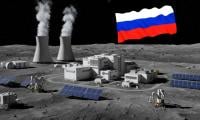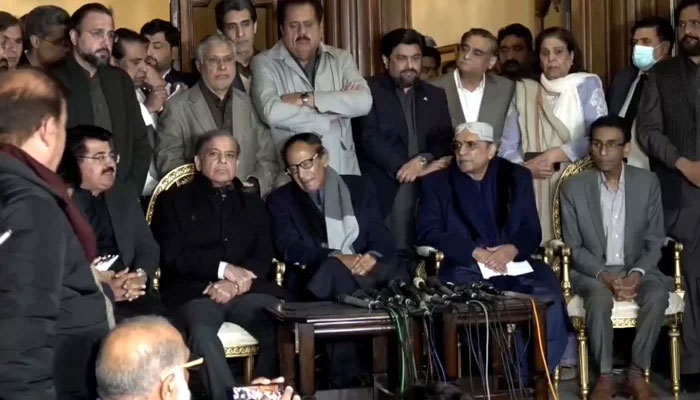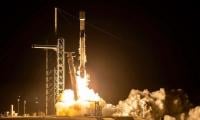Politics at stake
The PML-N-led coalition government will have more than 200 members in the National Assembly
The PML-N and PPP have formally announced a coalition government in Islamabad. Both parties have the numbers to form a stable coalition government. The MQM-P, IPP, PML-Q and BAP are likely to join the coalition.
The PML-N-led coalition government will have more than 200 members in the National Assembly. PML-N President Shehbaz Sharif has been nominated as prime minister. It is not clear at the moment whether the PPP will join the federal cabinet or not.
The decision to lead a coalition government at the federal level by the PML-N has put its politics at stake. The previous experience of the 16-month-long coalition government resulted in the PML-N losing support in its stronghold of Punjab. It burnt a lot of political capital during the last government.
Its support base eroded due to the tough economic decisions it made to stabilize the economy. Rising inflation, high unemployment and increased poverty made many people unhappy.
The PML-N tried to sell the narrative that the PTI government was responsible for the economic crisis and runaway inflation but failed to convince many voters. Many people refused to buy this narrative and abstained from voting. Independent voters punished the PML-N heavily in its strongholds.
The PML-N’s vote bank is on the decline in many central Punjab constituencies. The same is true in Hazara, Khyber Pakhtunkhwa which used to be the party’s stronghold.
PTI-backed independents posed a serious challenge to the PML-N in Punjab. The gap between the PML-N and the PTI narrowed down, and the PTI made big inroads in central Punjab. The PML-N’s poor performance in many central Punjab districts is a matter of concern. The revival of the PML-N in Punjab largely depends on the performance of the Shehbaz Sharif-led government. Its unsatisfactory performance will further erode the party’s support base and credibility.
The PML-N has played a big gamble here. If its government fails to complete its five-year tenure after making all the tough decisions under an IMF programme, it will face serious political consequences. It seems that the first two years are going to be tough for the new government.
The first task for the new setup will be to negotiate a new IMF programme worth $6 billion. The government will be forced to make tough economic decisions, and under the IMF programme, there will be little space for the government to provide much-needed relief to people. A further increase in inflation, poverty and unemployment is likely to make the government even more unpopular.
In the short term, the PTI might be able to gain more popularity. It will protest against any increase in the prices of gas, electricity and petrol. The key for the Shehbaz Sharif-led government is to complete its five-year term. To provide meaningful relief to the working class and the poor, the government requires five years.
If the government fails to complete five years and is toppled in the first couple of years, the PML-N will be in big trouble. It seems that the federal government will not be in a position to drastically cut the prices of electricity, gas and petrol and to offer subsidies to the most vulnerable sections of the population.
The country’s economic situation is likely to start improving in the third year. The federal government will be in a position to provide some relief to people after successfully completing the IMF programme and stabilizing the economy.
GDP growth is likely to remain low in the first two years. It might pick up pace in the third year. Job creation is directly linked with economic growth. To increase employment opportunities in the country, the government will require a high growth rate.
The PML-N has formed the government in Punjab and is all set to have Maryam Nawaz as the CM of Punjab. She will be the first-ever woman chief minister of Punjab.
The performance of the Maryam Nawaz-led Punjab government will also play an important role in reclaiming the lost ground in Punjab. Maryam has announced an ambitious agenda for her government. If she succeeds in delivering even 50 per cent of her promises and pledges, it will be considered a big success. If the Punjab government succeeds in providing some relief to people and reforming the health and education sectors, the PML-N will become stronger again. So there is a lot at stake not only in Punjab but also at the centre.
Failure is not an option for both Shehbaz Sharif and Maryam Nawaz. Both have the task of outperforming their opponents and competitors with good governance, corruption-free administration and service delivery. The political future of the PML-N is now in the hands of Shehbaz Sharif and Maryam Nawaz.
If both fail to perform well, the PML-N will likely be wiped out in the next election. Both the federal and Punjab governments will need political stability in the country to concentrate on governance and solve the problems faced by people. Political instability and uncertainty will create further problems for both governments.
The PTI as an opposition party will use every opportunity offered to them by the federal or Punjab government to destabilize the government. It will go to any lengths to create problems and hurdles for both governments.
For political stability in the country, the PML-N will not only have to keep the allies and coalition partners happy but also constructively engage with opposition parties.
The writer is a freelance journalist.
-
 Sarah Ferguson Considers Unique Surgical Approach To Seeking Forgiveness For Epstein Fiasco
Sarah Ferguson Considers Unique Surgical Approach To Seeking Forgiveness For Epstein Fiasco -
 Prince Harry, Meghan Markle Face Fresh Scrutiny Over Christmas Family Photo
Prince Harry, Meghan Markle Face Fresh Scrutiny Over Christmas Family Photo -
 Watch: Kate Middleton Promises An Extra Special Something For Together At Christmas
Watch: Kate Middleton Promises An Extra Special Something For Together At Christmas -
 Kim Kardashian Goes Incognito On Holiday Ski Trip, Fans Can’t Recognize Her
Kim Kardashian Goes Incognito On Holiday Ski Trip, Fans Can’t Recognize Her -
 King Charles Gives A History Lesson To Royal Fans Ahead Of Christmas Broadcast
King Charles Gives A History Lesson To Royal Fans Ahead Of Christmas Broadcast -
 How King Charles Is Reacting To Abdication Rumours, Prince William's Succession Talks?
How King Charles Is Reacting To Abdication Rumours, Prince William's Succession Talks? -
 Space Race Intensifies As Russia Plans Lunar Nuclear Power Plant By 2036
Space Race Intensifies As Russia Plans Lunar Nuclear Power Plant By 2036 -
 Italy Orders Meta To Suspend WhatsApp Terms Prohibiting Rival AI Chatbots
Italy Orders Meta To Suspend WhatsApp Terms Prohibiting Rival AI Chatbots -
 Serena Williams Surprises Sister With Most Expensive Wedding Gift
Serena Williams Surprises Sister With Most Expensive Wedding Gift -
 Kris Jenner Names Kardashian-Jenner Who Is The ‘hardest’ To Get Gifts For
Kris Jenner Names Kardashian-Jenner Who Is The ‘hardest’ To Get Gifts For -
 Should Meghan Markle, Prince Harry Return To The UK For Christmas? Royal Fans Give Verdict
Should Meghan Markle, Prince Harry Return To The UK For Christmas? Royal Fans Give Verdict -
 Prince Harry, Meghan Markle Emotional Moment With Injured Dog Revealed
Prince Harry, Meghan Markle Emotional Moment With Injured Dog Revealed -
 Scientist Find New Clue To Spot Mental Health Risk
Scientist Find New Clue To Spot Mental Health Risk -
 UFO Expert Makes Startling Revelation About Interaction With Aliens
UFO Expert Makes Startling Revelation About Interaction With Aliens -
 Prince Harry 'determined' To Secure Stable Future For Archie, Lilibet Away From Crown
Prince Harry 'determined' To Secure Stable Future For Archie, Lilibet Away From Crown -
 Trump Flew On Epstein Jet Eight Times In 90s, Prosecutor Email Claims
Trump Flew On Epstein Jet Eight Times In 90s, Prosecutor Email Claims




